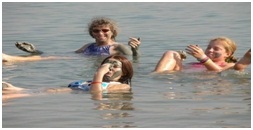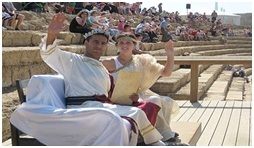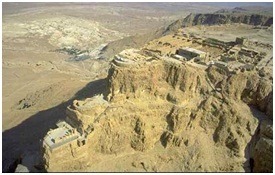Tel Aviv, Caesarea, Haifa, Nazareth, Sea of Galilee, Jerusalem, Dead Sea, Eilat
And more
Tel Aviv
Tel Aviv is located on the coast of the Mediterranean Sea; known as "The City That
Never Sleeps", Tel Aviv is a popular international tourist destination. It is renowned
for its 24-hour culture, beaches, bars, restaurants, cafés, parks, shopping, cosmopolitan
lifestyle,and
landmark neighborhoods such as Old Jaffa. Tel Aviv is an economic hub, home to the
Tel Aviv Stock Exchange, corporate offices and research and development centers.
It is the country's financial capital and a major performing arts and business center.
Tel Aviv is the 19th most expensive city in the world.
Nazareth
Nazareth is a popular tour destination for Christian pilgrims and a diverse city
home to a mix of races and religions. Nazareth lies in the
lower Galilee, near the Sea of Galilee. With a population of 65,000, Nazareth is
the largest city in the Northern District of the country. It is known as the Arab
Capital of Israel because its population consists primarily of Arab citizens. It
also serves as an economic and cultural center for Arabs living in adjacent towns.
Tiberias
Tiberias is situated on the western shore of the Sea of Galilee. It was built in
20 CE by Herod Antipas, the son of Herod the Great, and became the capital of his
realm in the Galilee. The city was named Tiberias in honor of the Roman Emperor
Tiberius.Tiberias has been venerated in Judaism since the middle of the 2nd century
CE and since the 16th century has been considered one of Judaism's Four Holy Cities,
along with Jerusalem, Hebron and Safed, In the 2nd-10th centuries, Tiberias was
the largest Jewish city in the Galilee and
the political and religious hub of the Jews of Palestine.According to Christian
tradition, Jesus performed several miracles in the Tiberias district, making it
an important pilgrimage site for Christians. Tiberias has historically been known
for its hot springs, believed to cure skin and other ailments, for thousands of
years.
Jerusalem - one of the oldest cities
in the world
The largest city and one of the oldest cities in the world, Jerusalem is holy to
more people than any other city on the planet. Jerusalem is a spiritual center for
Jews, Christians, and Muslims and is one of the most well-known travel destinations.
Visitors from every corner of the globe gather in Jerusalem to explore its fascinating
religious sites.
The Dead Sea
The "Salt Sea," this inland body of water is appropriately named, because its high
mineral content allows nothing to live in its waters. The Dead Sea is located in
the Syrian-African Rift, a 4000-mile fault line in the earth's crust, on the border
between Israel and Jordan. Its shoreline, at 1371 feet below sea level, is the lowest
point of dry land on earth. The Dead Sea is also the deepest salty lake in the

world: it is 1,083 feet deep and sits 2,621 feet below sea level. Nearly ten times
as salty as the world's oceans, the Dead Sea is rich with minerals. The Dead Sea
waters have long been known to have medicinal value and, as such, the Dead Sea area
has become a major center for health research and treatment. Health treatments exploit
the mineral content of the waters, the very low level of pollens and other allergens
in the atmosphere, the reduced ultraviolet component of solar radiation, and the
higher atmospheric pressure at this great depth. Each of the above has specific
medicinal benefits.

Caesarea (The Headquarters of the Romans) Caesarea, also known as Caesarea
Maritima, is a town located between Tel Aviv and Haifa on the Mediterranean coast.
Famous for its impressive archaeological park and stunning modern homes belonging
to Israel's elite, Caesarea is a popular attraction. No tour would be complete without
a visit to the beautiful seaside excavations at Caesarea National Park. Is capital
of Judea under the Romans. See the excavations of the Crusader city, Roman port,
aqueduct and the amphitheater that has been restored to its former glory as a concert
venue. Proceed to Megiddo, identified as the site of
Armageddon; visit the archaeological excavations including the well preserved water
supply system.
Haifa Nestled between Tel Aviv and the Lebanese border, Haifa is renowned
for its historical sites and scenic, unspoiled beaches. Haifa is the third largest
city in the country. It is located along Mediterranean coast in the Bay of Haifa.
Haifa is a bustling seaport. It is a major regional center that's located about
56 miles north of Tel Aviv. Landmarks that you can see in Haifa include the Baha'i
Gardens and World Center, which sits on the northern slope of Mount Carmel and features
a shrine, terraced gardens, and administrative buildings. Other notable
attractions in Haifa include the Cave of Elijah, a cave on Mt. Carmel where the
prophet Elijah lived during King Ahab's rule; the German Colony, which is comprised
of the remnants of a 19 th Century settlement and has become a fine dining hot spot;
Wadi Nisnas, the largest Arab neighborhood in Haifa; and Stella Maris, a French
Carmelite church, monastery, and hospice. Haifa is particularly appealing to tourists
because of its central location and good transportation. These characteristics render
the city an ideal jumping-off point for exploring the northern coast of the country.

Masada Desert Fortress Overlooking the Dead Sea
Masada is a mountain top desert fortress, built between 37-31 CE by King Herod atop
an isolated rock plateau in the Eastern Judean desert, overlooking the Dead Sea.
Masada became famous when during the Great Jewish Revolt (end of the Second Temple
Period, 66-73 CE) a siege of the fortress by Roman troops led to a mass suicide
of the site‘s Jewish defenders.
Masada is the name for a site of ancient palaces and fortifications in the Southern
District of Israel, on top of an isolated rock plateau, or horst, on the eastern
edge of the Judaean Desert, overlooking the Dead Sea. Masada is best known for the
violence that occurred there in the first century CE. In the final
accords of the First Jewish–Roman War, the Siege of Masada by troops of the Roman
Empire led to the mass suicide of the Sicarii rebels.
Eilat
Is the southernmost city, a busy port as well as a popular resort, located at the
northern tip of the Red Sea, on the Gulf of Aqaba. Home to 46,600 people, the city
is part of the Southern Negev Desert, at the southern end of the Arava. The city
is adjacent to the Egyptian village of Taba to the south, the Jordanian port city
of Aqaba to the east, and within sight of Saudi Arabia to the south-east, across
the gulf. Eilat's arid desert climate and low humidity is moderated by proximity
to a warm sea. Temperatures often exceed 40 °C (104 °F) in summer, and 21 °C (70
°F) in winter, while water temperatures range between 20 and 26
°C (68 and 79 °F). Eilat averages up to 360 sunny days a year. The city's beaches,
nightlife and desert landscapes make it a popular destination for domestic and international
tourism.
Qumran
Qumran is an archaeological site in the West Bank. It is located on a dry plateau
about a mile inland from the northwestern shore of the Dead Sea, near the Israeli
settlement and kibbutz of Kalia. The Hellenistic period settlement was constructed
during the reign of John Hyrcanus, 134-104 BCE or somewhat later, and was occupied
most of the time until it was destroyed by the Romans in 68 CE or shortly after.
It is best known as the settlement nearest to the caves in which the Dead Sea Scrolls
were hidden, caves in the sheer desert cliffs and beneath, in the marl terrace.
Jericho - The lowest permanently inhabited site on earth
Jericho is a city located near the Jordan River in the West Bank of the Palestinian
territories. It is the capital of the Jericho Governorate and has a population of
more than 20,000. Situated well below sea level on an east-west route 16 kilometers
(10 mi) north of the Dead Sea, Jericho is the lowest permanently inhabited site
on earth. It is also believed to be one of the oldest continuously inhabited cities
in the world. Described in the Old Testament as the "City of Palm Trees", copious
springs in and around Jericho have made it an attractive site for human habitation
for thousands of years. It is known in Judeo-Christian tradition as the place of
the Israelites' return from bondage in Egypt, led by Joshua, the successor to Moses.
Archaeologists have unearthed the
remains of more than 20 successive settlements in Jericho, the first of which dates
back 11,000 years (9000 BCE), almost to the very beginning of the Holocene epoch
of the Earth's history.